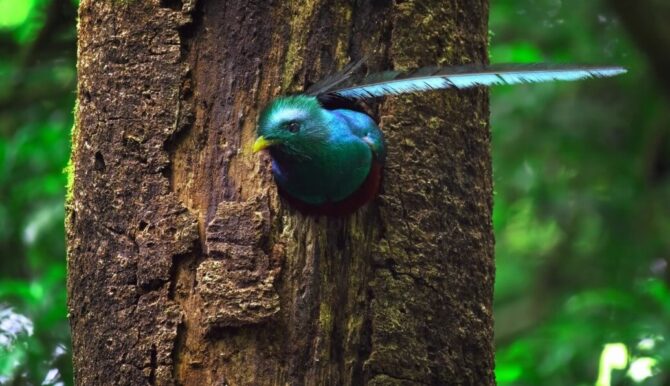Bird-watching is such a fun activity. Who wouldn’t want to be surrounded by flying beauty?
For all birdwatchers out there, we’ve rounded up the top 20 gorgeous birds you’ll ever see.
Some of the most beautiful birds in the world include the Nicobar pigeon, bluebird of paradise, scarlet macaw, flamingo, blue jay, and mandarin duck, to mention a few.
Very few creatures on our planet are as lovely as birds, with their vibrant colors and patterns.
Explore the fascinating world of birds, where each one is a unique display of colors and shapes. Get ready to meet birds that stand out for their incredible colors and fascinating features. Our list explores all vital information on each species, and where you can find them.
Top 20 Most Beautiful Birds in The World
1. Mandarin Duck

- Scientific Name: Aix galericulata
- Length: 16 to 19 inches
- Weight: 1.4 to 2.4 pounds
- Wingspan: 26 to 30 inches
- Identifying Features: Red bill, white crescent, purple breasts, green tail
- Where Found: East Palearctic region
- Conservation Status: Least Concern
The mandarin duck is a medium-sized perching duck species, which means it is likely to be found perched on trees.
Its native region is the East Palearctic, which comprises North Africa, all of Europe, and Asia.
It wasn’t a native of Great Britain, but it was introduced there after a while. A smaller population can be found in North America as well.
The mandarin duck captures the eye the minute you see it. Males are the more colorful sexes, but overall you’ll find both a delight to watch.
These birds combine different colors—like purple, white, orange, and red—to make up a lovely whole. The main features include purple breasts, a red bill, and a green tail.
They are quite shy, especially when compared to the bolder behaviors of other duck species. That said, taming by humans can make them more courageous.
In looks, they are often compared with the wood duck, which is on this list too. The Mandarin duck is usually in pairs, making it a symbol of love.1
Best Places to See the Mandarin Duck:
- Wuyuan, China
- Takaragaike Park, Kyoto, Japan
- Windsor Great Park, Southern England
- California, United States
Related: Check Out These Amazing Birds with Mohawks
2. Nicobar Pigeon

- Scientific Name: Caloenas Nicobarica
- Length: 16 inches
- Weight: 1 to 2 pounds
- Wingspan: 21 and 23 inches
- Identifying Features: Iridescent feathers, grey head, white tail
- Where Found: India, Malaysia, Vietnam, Indonesia, Philippines
- Conservation Status: Near Threatened
The Nicobar lives majorly on the Island, which bears its name, the Nicobar Islands.
It can also be found in some islands and coastal regions like the Malay archipelago, the Solomons, and Palau.
The Nicobar pigeon is listed as Near Threatened because of the high level of hunting done against it, but it remains the only surviving member of its genus. 2
It is a large bird, getting up to 16 inches in length. Coupled with the iridescent feathers, this bird is hard to miss.
It also comes with a grey head, white tail, and an overall green plumage. Females are slightly smaller than males, and there are some differences in coloration.
A very vocal bird, the Nicobar pigeon emits a low-pitched call. It usually roams in flocks, going from Island to Island.
It isn’t shy, so you can see it around places where humans live.
Best Places to See the Nicobar Pigeon:
- Milwaukee County Zoo, Wisconsin, United States
- Islands (Solomons, Nicobar…)
3. Blue Jay

- Scientific Name: Cyanocitta cristata
- Length: 9 to 12 inches
- Weight: 2.5 to 3.5 ounces
- Wingspan: 13 to 17 inches
- Identifying Features: Blue top and white chest, blue crest
- Where Found: Eastern and Central United States
- Conservation Status: Least Concern
The blue jay is classified as a passerine bird, also known as a perching bird, because of its ability to perch.
It belongs to the Corvidae family and is native to eastern North America.
You can find them in the United States, usually in the eastern and central regions. You can also find a lot in Canada.
The blue jay is similar to the morning skies in its color combination. This bird is predominantly blue—as the name shows—especially in the upper parts.
Their chest is white, the collar is black, and the crest is blue. Males and females are alike, it is hard to make a difference.
The name jay comes from the bird’s nature. This isn’t a quiet, shy creature.
The blue jay is very noisy and gregarious, a trait that applies to all birds of the same family.
Related: These Beautiful Purple Birds are a Sight to Behold
4. Scarlet Macaw

- Scientific Name: Ara Macao
- Length: 32 inches
- Weight: 2 pounds
- Wingspan: 3 feet
- Identifying Features: Scarlet plumage, multi-colored wings,
- Where Found: Mexico, Peru, Bolivia, Brazil, Bolivia
- Conservation Status: Least Concern
The scarlet macaw is a parrot that can be found in Central and Southern America.
It is easily recognized by the color combination of red, yellow, and blue, and with a length of 32 inches, it is bigger than many other parrot species out there.
It also has broad wings. Amongst all macaws, it is the most striking one.
Just as its name implies, this bird’s plumage is mostly scarlet, but the wing feathers feature different colors like red, yellow, blue, and even green on some individuals.
The tail is long, making up about half of the total length.
These birds are also easy to find in their various habitats. They make different vocal sounds like a squawk, a scream, or a squeak.
Their preferred habitats include woodlands, subtropical rainforests, and savannahs.
Best Places to See the Scarlet Macaw:
- Carrara Reserve, Jaco
- Corcovado National Park, Osa Peninsula
5. Flamingo

- Scientific Name: Phoenicopteridae
- Length: 0.8 to 1.4m
- Weight: 5.5 to 7.7 pounds
- Wingspan: 37 to 59 inches
- Identifying Features: Pink feathers, black-tipped wings
- Where Found: Americas, Africa, Europe
- Conservation Status: Least Concern
Flamingos are birds belonging to the family Phoenicopteridae, and there are six species in existence.
Four of these species live across America, and the last two live in Africa, Europe, and Asia.
A group of flamingos is called a flamboyant because it is vivid, captures the eye, and stands out in its natural environment.
The most noticeable physical trait of the flamingo is the pink color. It also has a black bill, long legs, and an equally long neck.
These birds are categorized as wading birds alongside some others, like storks and herons.
Wading birds are known to glide over shorelines, hence their names.
Flamingos tend to stand on one leg, a good way to distinguish them from other birds.
No one is quite sure why they do this, but some theories exists. One such is that it helps conserve heat.
Best Places to See the Flamingo:
- Paracas National Reserve, Peru
- Renaissance Island, Aruba
- Lake Bogoria, Kenya
- Lake Qarun, Egypt
Related: Discover Amazing African Safari Birds
6. Blue Bird of Paradise

- Scientific Name: Paradisornis rudolphi
- Length: 30 cm
- Weight: 4.3 to 6.7 pounds
- Wingspan: 7.9 to 47 inches
- Identifying Features: Black striking plumage, blue wings, white or grey bill, silver-white crescent
- Where Found: Papua New Guinea
- Conservation Status: Near Threatened
The Blue Bird-of-Paradise is a large, beautiful species, one that comes with striking plumage that is attractive.
Its physical characteristics make it one of the most extravagant and fabulous birds in the world.
It is the only species in the genus Paradisornis. The bird is considered endangered because of habitat loss and hunting.
The first defining feature of the blue bird-of-paradise is the blue wings, which are present in both sexes.
They have a blue tail which can come in different shades.
Every other part of the male body is usually black, with white crescents surrounding the eyes.
The female’s underparts are colored chestnut brown. Males have flank plumes that are used to attract females.
While that may be subjective, you can’t deny that the blue bird of paradise reminds you a little of paradise.
Best Places to See the Blue Bird-of-Paradise:
- Mount Sisa, Papua New Guinea
- Owen Stanley Range
7. Golden Pheasant

- Scientific Name: Chrysolophus pictus
- Length: 24 to 41 inches
- Weight: 12.3 to 24.7 ounces
- Wingspan: 28 inches
- Identifying Features: Dark wings, yellow crown, red underparts, barred tail
- Where Found: China, countries in the Americas, and Europe
- Conservation Status: Least Concern
The Golden pheasant is also known as the Chinese pheasant and the rainbow pheasant, and it is a native of China.
It is classified under the game bird order, which incorporates chickens, turkeys, and some other birds that stay more on the ground.
This bird bears some resemblance to the chicken, though they are not identical.
Males are more colorful than females, they have a mottled brown plumage that pales in comparison to the flashy colors of their male counterparts.
The male has a long tail, longer than its upper body length.
Its overall plumage color is a bright red, supplemented by others like gold, black, green, and orange. Both genders have yellow legs and yellow bills.
Besides China, the golden pheasant has been introduced in other European and American countries like the United Kingdom, United States, Canada, Germany, Belgium, and a list of many others.
Best Places to See the Golden Pheasant:
- Wolong National Nature Reserve, China
- Changqing Nature Reserve, China
- Tangjahe Nature Reserve, China
8. Red-Necked Tanager
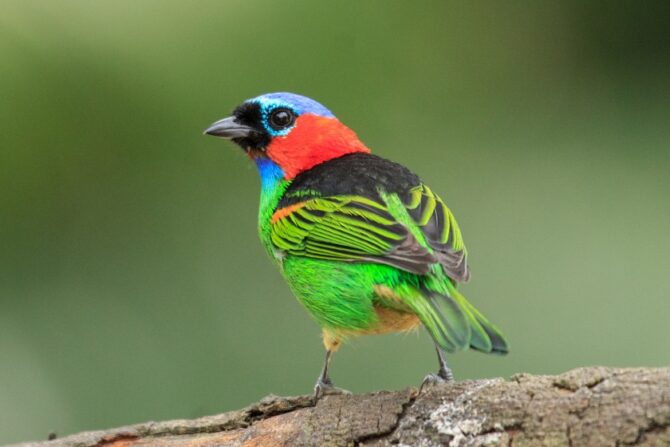
- Scientific Name: Tangara cyanocephala
- Length: 13cm
- Identifying Features: Green plumage, blue crown, black back
- Where Found: Brazil, Argentina, Paraguay
- Conservation Status: Least Concern
The red-necked tanager is a part of the Thraupidae family, and while not much is known about it, it is undoubtedly one of the most beautiful birds you’ll see.
It is a South American bird living in Paraguay, Argentina, and Brazil.
The overall color of the red-necked tanager is green, but there are many other combinations.
As the name states, its neck is red. Additional colors include black, a blue head, and a throat.
9. Blue Crowned Pigeon

- Scientific Name: Goura cristata
- Length: 28 inches
- Weight: 3.8 to 4.6 pounds
- Wingspan: 36 to 39 cm
- Identifying Features: Blue plumage, brown shoulders, white spot
- Where Found: New Guinea
- Conservation Status: Vulnerable
The blue crown pigeon is also known as the Western crowned pigeon or the common crowned pigeon.
It is one of the largest pigeons in the world, alongside birds like the Victoria crowned pigeon, the Sclater crowned pigeon, and the Scheepmaker crowned pigeon.
Just one look at this bird is enough to conclude that the blue crown pigeon is a beautiful bird.
It is predominantly blue, even around its eyes, though there are shades of grey around it.
Both the male and female are similar in looks, but the male is bigger. These birds are vulnerable, and seeing them is worth it.
Best Places to See the Blue Crown Pigeon:
- Lowland rainforest of New Guinea
10. Peafowl

- Scientific Name: Phasianidae
- Length: Varies
- Weight: 3.8 to 6 kg
- Wingspan: 5ft
- Identifying Features: The train (tail), blue and green plumage
- Where Found: Asia, Africa
- Conservation Status: Varies
The peafowl is the collective name for these extravagant birds that are classified in the genera Pavo and Afropavo, all under the family Phasianidae.
While both sexes are sometimes called peacocks, in the actual sense, only the male peafowl is called a peacock.
There are three species, two of which are in Asia and the third in Africa.
There’s a reason the expression “as proud as a peacock” exists. These birds are beautiful and seem to know it, judging by the display of their “tails.”
The latter is more accurately called a train and is found in males. The train is made of feather coverts and is iridescent.
When the bird opens the train, you will see eyespots marking the feathers.
They seem to do this to attract females, but it may also be a display of strength.
Not all males of different species can display their tail feathers, though. For example, the Congo peacock doesn’t do this.
Best Places to See the Peafowl
- Kanha National Park, India
- Sariska Tiger Reserve, India
- Mayfield Park, Austin
11. Red Crested Turaco
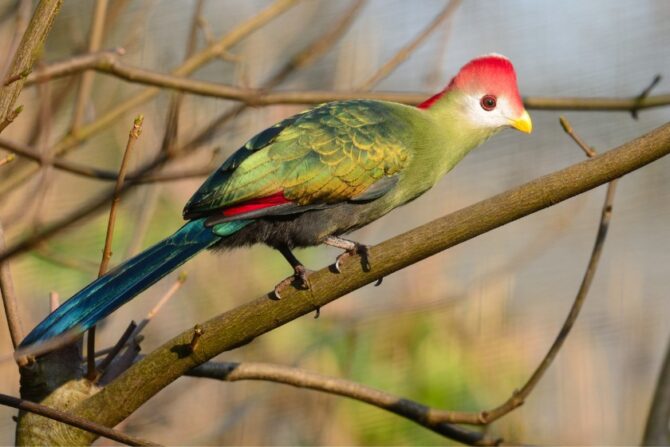
- Scientific Name: Tauraco erythrolophus
- Length: 45 to 50 cm
- Weight: 210 to 325g
- Wingspan: 8 inches
- Identifying Features: white face, red crest, yellow beak
- Where Found: Angola
- Conservation Status: Least Concern
The red-crested turaco is a native of Angola, the only place it can be found.
It is classified as a turaco, a group of birds with similar characteristics like eating plantain.
Turacos are found in Africa, including the red-crested. The latter is often seen in a flock or a pair and is a remarkable bird.
The predominant color of the red-crested bird is green, and only the crest is colored red.
The upper parts are a darker green than the lower region, and the face is white.
It is usually compared to another bird known as the Bannerman’s Turaco, but there are a couple of differences.
Unlike some other birds we’ve seen, the differences between the sexes are minimal.
The red-crested turaco is the national bird of Angola. Its call is like that of an
12. Horned Sungem

- Scientific Name: Heliactin bilophus
- Length: 3.7 to 4.3 inches
- Weight: 1.8 to 2.8g
- Identifying Features: Dark blue crown, horn tufts
- Where Found: Bolivia, Brazil, Suriname
- Conservation Status: Least Concern
The horned sungem is a hummingbird species, and like all hummingbirds, it is eye-catching.
It is mostly found in South America, especially in places like Bolivia, Brazil, and Suriname.
The horned sungem is the only member of its genus and has no subspecies.
The major physical feature of the horned sungem is the feathers at the top of the head that look like horns. It also comes in different colors, including black, red, blue, and gold.
Females don’t have horns, though, and they are less colorful.
It inhabits woodlands, grasslands, forests, and gardens.
Best Places to See the Horned Sungem:
- South American countries
13. Snowy Owl

- Scientific Name: Bubo scandiacus
- Length: 0.79 to 0.98 inches
- Weight: 2kg
- Wingspan: 4 to 5 ft
- Identifying Features: White plumage, black or brown markings,
- Where Found: Arctic regions
- Conservation Status: Vulnerable
The snowy owl is of the true owl family, and it also goes by other names like the Arctic owl, the polar owl, and the white owl.
It is from the Arctic tundra regions found both in North America and the Palearctic.
Snowy owls became popular thanks to Hedwig in Harry Potter, and many who owl seek a chance to see a snowy owl.
This bird is majorly white, but only a few individuals are fully so. Males tend to be whiter than females, but most of them have black spots that tend to reduce as they grow older.
Snowy owls are also quite large, making it easy to see them and they are known to be good for sending messages.
Snowy owls have seasons of migration where they move towards other regions, including different cities in the United States.
Best Places to See the Snowy Owl:
- Salisbury State Park
- Plum Island
- Duxbury Beach
14. Azure Kingfisher
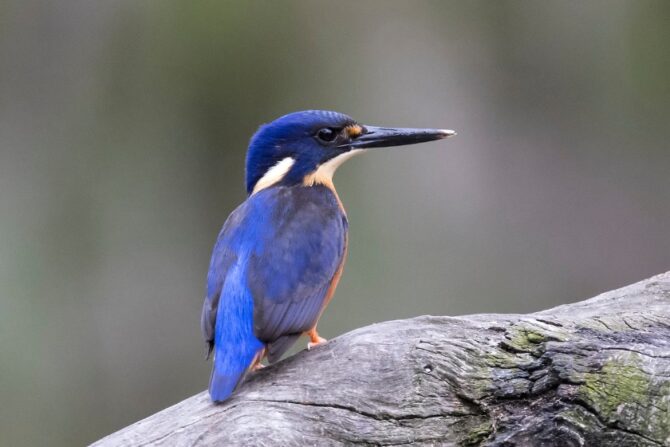
- Scientific Name: Ceyx azureus
- Length: 6.7 to 7.5 inches
- Weight: 29 to 35g
- Wingspan: 25 to 29 cm
- Identifying Features: Black bill, short tail, violet plumage, orange spot at the eye
- Where Found: Australia, Tasmania, New Guinea, Indonesia, Romania
- Conservation Status: Least Concern
The Azure kingfisher is spread out in different countries like Australia, Indonesia, and some islands (New Guinea and Romang).
It is also known as the blue kingfisher because of its predominantly blue color. It is both a beautiful bird and an excellent hunter.
Females are heavier than males, but both sexes are similar. The azure kingfisher is colored blue with the back being azure.
There’s also a white spot on the neck and throat, then the red feet. This bird is usually silent but can sometimes make a sharp call.
Best Places to See the Azure Kingfisher:
- Northern and Eastern Australia
- Moluccas and lesser Sundaes
15. Atlantic Puffin
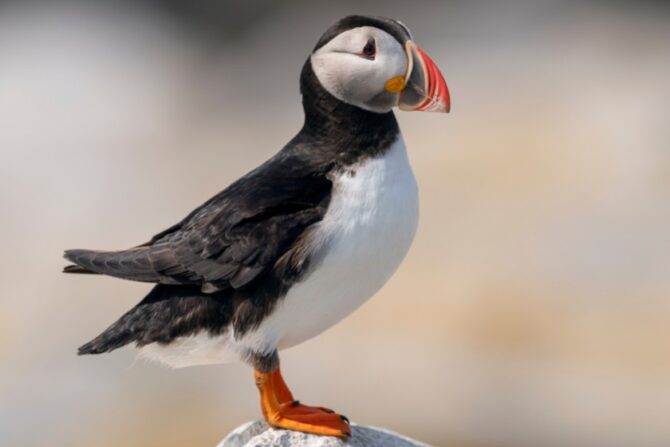
- Scientific Name: Fratercula arctica
- Length: 11 to 12 inches
- Weight: 490g
- Wingspan: 19 to 25 inches
- Identifying Features: white chest, webbed feet, black upper
- Where Found: Russia, Iceland, Ireland, France, Canada
- Conservation Status: Vulnerable
The Atlantic Puffin is also known as the common puffin, and it is a seabird species.
This bird has an extended range that covers different continents, from Europe to North America.
It is related to two other puffin species known as the “tuftin puffin” and the horned puffin, all under the same genus.
It is the only puffin that stays close to the Atlantic Ocean. Others are found in the northeastern Pacific.
The Atlantic Puffin is sometimes termed the “sea parrot” because it resembles parrots, especially at the level of the beak.
Its coloration is similar to that of the penguin, with black upperside and white underneath.
Males are slightly larger than females, but overall they look identical. The wings are short, and the bill is multicolored, adding to the appeal.
Best places to see the Atlantic Puffin:
- Island of Maine
- Lundy, England
- Nuuk, Greenland
16. Keel-Billed Toucan
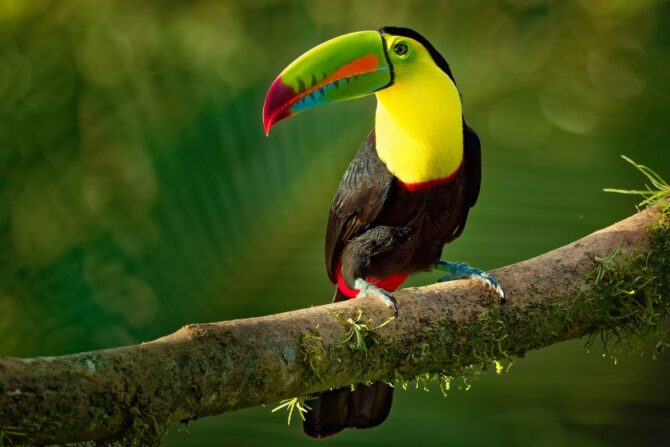
- Scientific Name: Ramphastos sulfuratos
- Length: 17 to 22 inches
- Weight: 13 to 18 ounces
- Wingspan: 40 to 63 inches
- Identifying Features: multicolored bill, black plumage
- Where Found: Mexico, Belize, Colombia
- Conservation Status: Near Threatened
The keel-billed toucan is also known as the rainbow-billed toucan and the sulfur-breasted.
It is of the toucan family and is located in South America, especially in countries like Colombia and Mexico.
True to its name, the standout feature of this toucan is the multicolored bill.
The latter is quite long, adding to the keel-billed toucan’s overall length.
The plumage is black, but the neck and chest are yellow. It spends a lot of time on trees and can be found in rainforest habitats.
It has a peculiar sound, more like a frog croaking than a bird chirping.
Best Places to See the Keel-billed toucan:
- Mountains of the Central Valley, Costa Rica
- Tortuguero National Park
17. Wood Duck

- Scientific Name: Aix sponsa
- Length: 47 to 54 cm
- Weight: 450g
- Wingspan: 28 to 39 inches
- Identifying Features: broad tail, chested head, thin neck
- Where Found: North America
- Conservation Status: Least Concern
The wood duck is a perching duck species because of its ability to perch on trees—an ability all perching ducks have.
The wood duck is one of the most colorful birds you’d find in North America, where it is a native.
Another name for the wood duck is the Carolina duck.
Males are the more colorful gender, similar to what we’ve seen with other species on here.
Their plumage is multicolored and Iridescent, with a white neck. The eyes are red, but not in a scary way.
Altogether, the colors come together to make the drake look beautiful. You can spot the female easily because is less colorful.
Best Places to See the Wood Duck:
- Swamps
- Wood fringed marshes
- Beaver ponds
18. Bohemian Waxwing
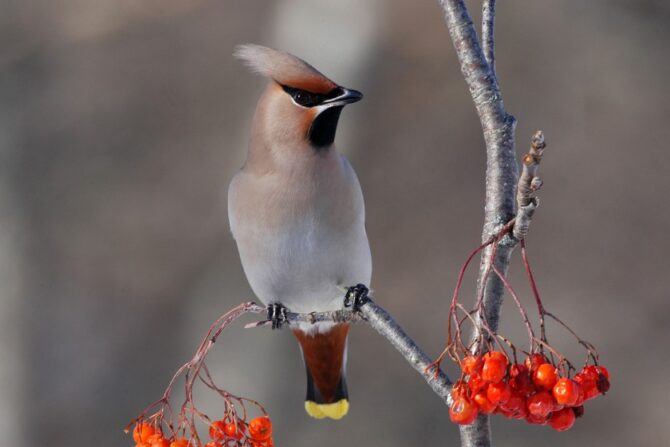
- Scientific Name: Bombycillia Garrulus
- Length: 7.5 to 9.1 inches
- Weight: 1.9 ounces
- Wingspan: 12.6 to 14.0 inches
- Identifying Features: Short tail, crest on the head, dark brown eyes
- Where Found: North America, Palearctic
- Conservation Status: Least Concern
The bohemian waxwing is often found in the Palearctic forests or North America.
It is a perching bird like some aforementioned species and can further be classified into three subspecies.
In looks, it is often compared to the Japanese waxwing, a relative, while in size, it is similar to the common starling.
The two main colors of the Bohemian waxwing are brown or grey, and one quick way to identify this bird is with the crest on the head.
The wings are black with feather markings that are yellow and white.
Best Places to See the Bohemian Waxwing:
- Palearctic forests
- North America
19. Hyacinth Macaw
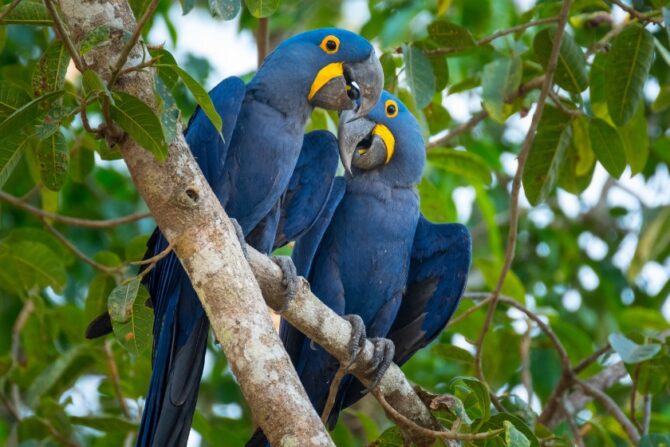
- Scientific Name: Anodorhynchus hyacinthinus
- Length: 3ft3 inches
- Weight: 1.2 to 1.7kg
- Wingspan: 38.8 to 42.5 cm
- Identifying Features: Blue feathers, long and pointed tail, yellow eye rings
- Where Found: South America
- Conservation Status: Vulnerable
The hyacinth macaw is a native of Central and South America.
It is the longest parrot species in the world and no doubt one of the most beautiful.
The hyacinth macaw is also the largest macaw and the largest flying parrot. These are a lot of achievements for one bird.
This beautiful bird is predominantly blue, though the neck of some individuals is gray.
The bill is also gray, while there’s yellow at the eye rings and underneath the bill.
Hyacinth macaw is classified as vulnerable by the IUCN due to habitat loss.
Best Places to See the Hyacinth Macaw:
- Rainforests in Brazil, Bolivia, and Paraguay
- Barba Azul Nature Reserve
20. Rainbow Lorikeet

- Scientific Name: Trichoglossus moluccanus
- Length: 3.8 to 11.8 inches
- Weight: 2.6 to 5.5 ounces
- Wingspan: 6.7 inches
- Identifying Features: red beak, multi-colored plumage
- Where Found: Australia
- Conservation Status: Least Concern
The rainbow lorikeet is so named because of the multiple colors on its plumage, and it is the only parrot species that can be found in Australia.
It often moves in pairs, and seeing them is a birdwatching treat.
The rainbow lorikeet is medium-sized and stands out because of its plumage, and the latter comes with a color combination of green, orange, yellow, and blue.
There’s also black on the beak of the young juvenile, which then turns to yellow.
Best Places to See the Rainbow Lorikeet:
- Centennial Parkland, Sydney
- Thala Beach Nature Reserve, Australia
Conclusion
Birdwatching can be a fun activity, and with so many beautiful bird species, it’s not hard to see why!
Don’t miss the opportunity to view some of nature’s best artworks in the birds we’ve listed.
Know any other beautiful birds that we might have missed? Let us know in the comments below!
Next up…
- 10 Rarest Birds in the World & Where To Find Them
- 15 Biggest Birds In The World (Largest Species + Pictures)
References & Notes
- Mandarin Ducks – Powerful Feng Shui Love Symbol. The Chinese Zodiac.
- Nicobar Pigeon. Avibase.



